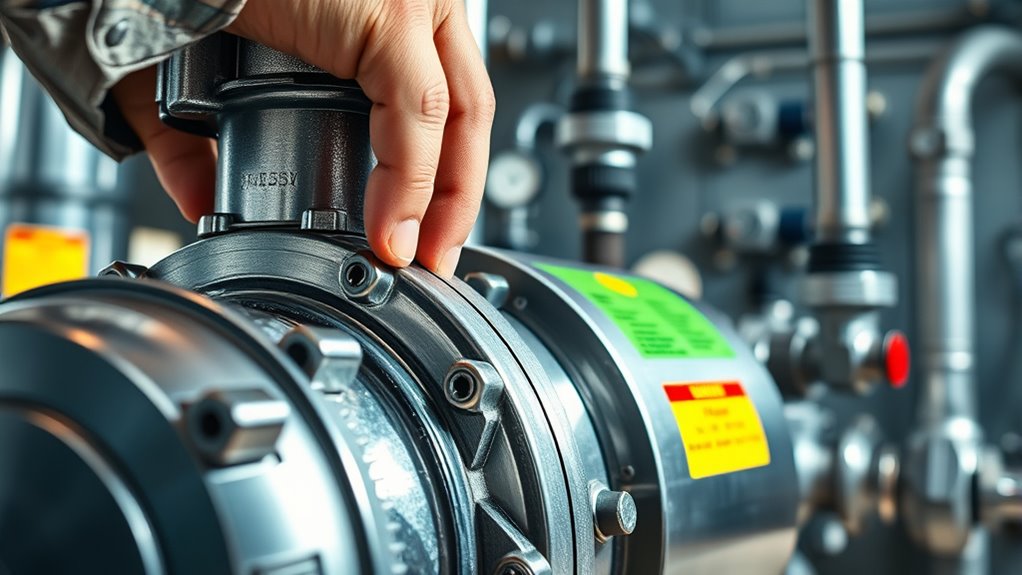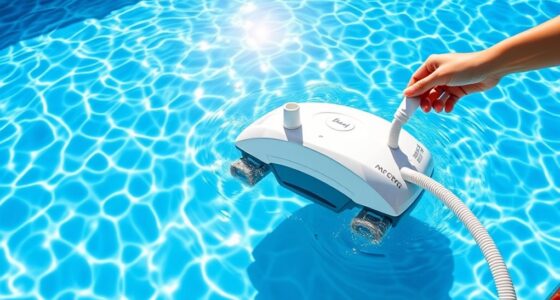To maintain your booster pump, regularly inspect it for leaks, unusual vibrations, and signs of wear or corrosion. Clean or replace filters, flush out debris, and apply lubrication to moving parts following manufacturer guidelines. Keep an eye on pressure and flow rates, adjusting settings if needed. Schedule professional servicing regularly to catch potential issues early and guarantee the best performance. If you want detailed tips, keep going to learn more about keeping your booster pump in top shape.
Key Takeaways
- Conduct regular visual inspections for leaks, corrosion, and loose connections.
- Clean or replace filters and flush the system to prevent debris buildup.
- Lubricate bearings, shafts, and gears following manufacturer recommendations.
- Monitor pressure and flow rates, calibrating gauges regularly for accuracy.
- Schedule professional servicing to identify wear early and ensure optimal performance.
Regular Inspection and Visual Checks
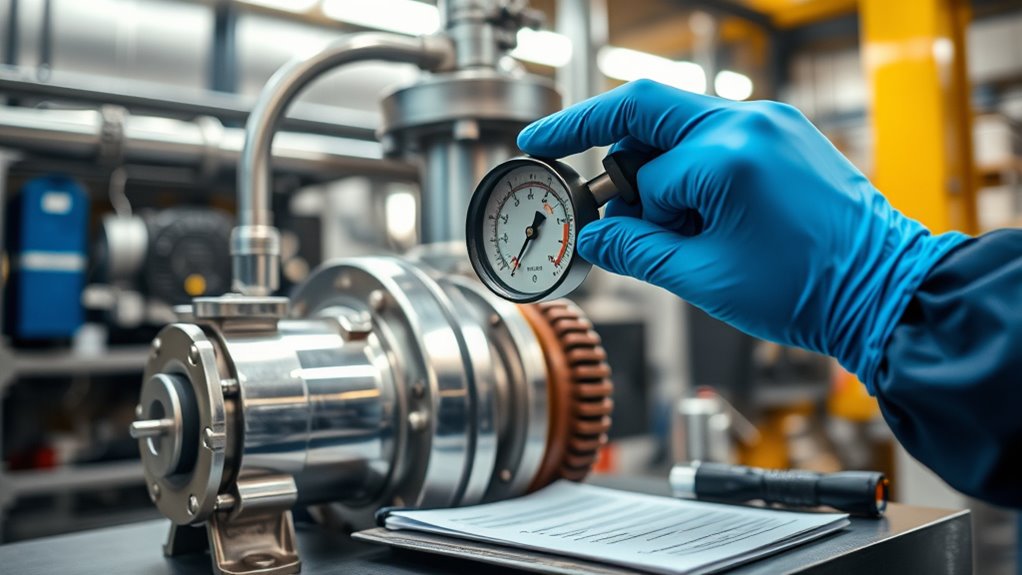
Regular inspection and visual checks are essential to keep your booster pump running smoothly. Start by observing the pump for any unusual vibrations, which can indicate misalignment or bearing issues. Vibration analysis helps catch problems early before they escalate, ensuring peak operation. Additionally, inspect the seals regularly for leaks, cracks, or wear, as seal integrity is vital to prevent fluid loss and contamination. Look for signs of corrosion or corrosion-related damage on the pump housing and fittings. Check for loose bolts or connections and tighten them if necessary. Maintaining a routine inspection schedule allows you to identify potential issues early, reducing downtime and costly repairs. Incorporating professional equipment into your inspections can further improve detection accuracy and overall maintenance effectiveness. Regular monitoring of pump performance metrics is also crucial to maintaining optimal efficiency over the long term. Paying attention to seal integrity can prevent leaks and extend the lifespan of your pump, ensuring consistent operation and reducing maintenance costs. Additionally, establishing a preventive maintenance plan can help address issues before they become critical and prolong the life of your booster pump. Regularly reviewing tuning adjustments can also ensure your pump remains optimized for your specific operational needs.
Cleaning and Flushing the System

To guarantee peak performance, you should thoroughly clean and flush your booster pump system periodically. This process removes debris, prevents buildup, and maintains excellent filtration upgrades. Flushing helps eliminate mineral deposits and corrosion-causing materials, extending your pump’s lifespan. Focus on cleaning filters and inspecting for signs of corrosion; replacing filters when necessary is crucial. Use a cleaning solution suitable for your system to ensure thorough flushing. Consider the table below for key aspects:
| Step | Action | Purpose |
|---|---|---|
| Filter Cleaning | Remove and clean or replace filters | Improve filtration efficiency |
| System Flushing | Run water through system to clear debris | Prevent corrosion and buildup |
| Inspection | Check for corrosion signs | Early detection of issues |
Regular cleaning enhances performance and longevity. Additionally, staying informed about AI discoveries can offer insights into innovative solutions for maintenance and troubleshooting.
Lubricating Moving Parts

Lubricating the moving parts of your booster pump is vital for maintaining smooth operation and preventing premature wear. Use proper lubrication techniques by applying the recommended lubricant to bearings, shafts, and gears. Regularly check the manufacturer’s guidelines to determine proper lubrication intervals, as over-lubricating can cause buildup, while under-lubricating leads to increased friction. Before applying lubricant, clean the parts to remove dirt and debris that could contaminate the lubrication. Always use the specified type of lubricant to guarantee compatibility and peak performance. Consistent lubrication reduces friction, minimizes noise, and extends the lifespan of your pump. Keep a maintenance schedule to track lubrication intervals and stay proactive in your pump’s upkeep. Proper lubrication is a simple yet vital step in keeping your booster pump running efficiently. Researching proper maintenance practices can further improve your pump’s longevity and performance. Additionally, understanding how wear and tear affects pump components can help in diagnosing issues early and ensuring optimal operation. Regular inspections for signs of component degradation can also prevent unexpected failures and costly repairs. Paying attention to lubricant quality ensures that the lubrication remains effective over time and does not compromise the pump’s performance.
Monitoring Pressure and Flow Rates
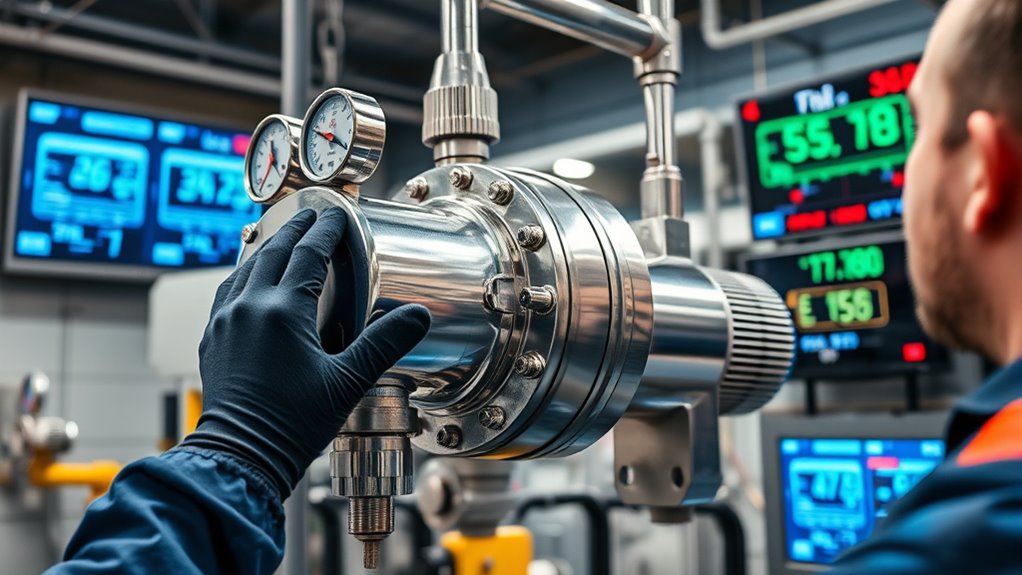
Have you checked your booster pump’s pressure and flow rates lately? Monitoring these parameters is vital for peak performance. First, regularly inspect the pressure gauge calibration to guarantee accurate readings. Second, measure flow rates to confirm they meet system requirements. Third, adjust the pump settings if flow rate optimization isn’t achieved, preventing strain or inefficiency. Fourth, record your readings to identify trends or deviations over time. Properly calibrated pressure gauges prevent misdiagnoses, saving you troubleshooting time. Consistently monitoring flow rates ensures your system runs smoothly without waste. Additionally, understanding the importance of consistent system maintenance can help prevent unexpected failures. Regularly inspecting components like pressure regulators can further enhance system reliability. Using proper testing procedures and monitoring techniques ensures your booster pump operates at optimal efficiency. Employing proper calibration methods guarantees accurate readings and helps avoid unnecessary repairs. Staying informed about pressure and flow rate standards allows you to maintain compliance and optimal performance. By staying vigilant, you can catch issues early, extend your pump’s lifespan, and maintain peak performance. Regular checks are simple but necessary steps in effective booster pump maintenance.
Scheduling Professional Servicing
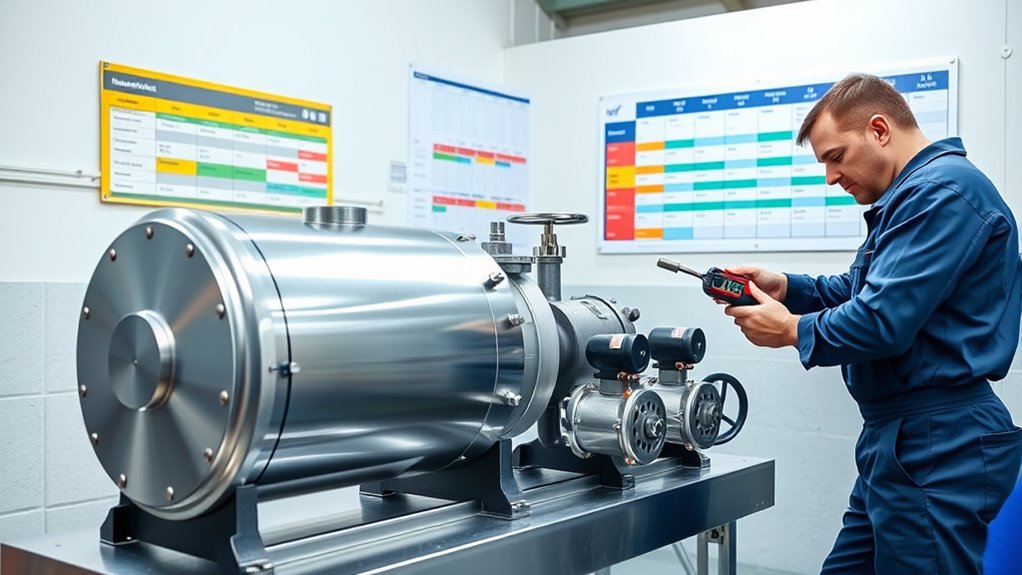
Scheduling professional servicing for your booster pump guarantees it operates reliably and efficiently over time. Regular maintenance helps identify issues early, reducing the risk of emergency repairs that can disrupt your system. During servicing, technicians check for wear and tear, ensuring all components function correctly. They also handle spare parts procurement, so you’re prepared for replacements when needed. In addition, staying aware of air quality can inform maintenance needs, as poor air conditions may stress your pump. Proper equipment maintenance is essential for maintaining optimal operation and preventing costly breakdowns. Regularly reviewing support hours can help you plan service visits during convenient times and avoid delays. It also ensures compliance with legal and safety standards, safeguarding your investment. Additionally, adhering to a maintenance schedule can improve the overall lifespan of your booster pump. Don’t wait for a breakdown; proactive maintenance keeps your system running smoothly and saves you money on costly repairs. Trust qualified technicians to keep your booster pump in top condition.
Frequently Asked Questions
How Long Should a Booster Pump Typically Last Before Replacement?
A booster pump’s lifespan varies, but generally, you can expect about 8 to 15 years before needing replacement. Regular maintenance and proper care can extend its replacement timeline. Keep an eye on signs like decreased pressure or unusual noises, which indicate it’s time for a replacement. By monitoring these factors, you ensure your pump operates efficiently and lasts as long as possible, saving you money and hassle.
What Are the Signs of a Failing Booster Pump?
Think of your booster pump as the heartbeat of your water system. When it starts to falter, you’ll notice a drop in pump efficiency and strange noises that disrupt the quiet rhythm. You might see reduced water pressure or increased noise levels, signaling it’s struggling. Don’t ignore these signs; they’re like warning lights on your dashboard, telling you it’s time to check for issues and restore smooth, quiet operation.
Can I Upgrade My Booster Pump for Better Efficiency?
If you’re wondering whether you can upgrade your booster pump for better efficiency, the answer is yes. You can choose a model with quieter operation to reduce pump noise and higher efficiency ratings to save energy. Upgrading guarantees smoother performance and less maintenance. Just make sure to select a pump compatible with your system and consult a professional to maximize benefits. This way, you’ll enjoy quieter and more efficient operation.
What Safety Precautions Should I Take During Maintenance?
During maintenance, you should prioritize safety by wearing personal protective equipment like gloves and goggles to prevent injuries. Always guarantee electrical safety by disconnecting the power supply before working on the pump. Check for any leaks or damage, and handle tools carefully. Keep the work area clean and well-lit. If you’re unsure, consult the manufacturer’s guidelines or a professional to avoid accidents and ensure safe, effective maintenance.
How Do Environmental Factors Affect Booster Pump Performance?
Environmental impacts can substantially affect booster pump performance. Exposure to extreme temperatures, humidity, dust, or corrosive elements can reduce pump durability and cause malfunctions. You should verify the pump is installed in a protected, clean environment and regularly inspect for damage. By managing these environmental factors, you help extend the lifespan of your pump and maintain ideal performance, avoiding costly repairs and downtime.
Conclusion
By regularly inspecting, cleaning, lubricating, and monitoring your booster pump, you guarantee it runs smoothly—like a well-tuned instrument. Remember, even the strongest machines need care to stand the test of time. Think of it as tending to a garden; with consistent attention, your pump will perform reliably, just as a gardener’s patience yields bountiful blooms. Keep up the maintenance, and your pump will serve you faithfully, echoing the timeless truth that care sustains greatness.

